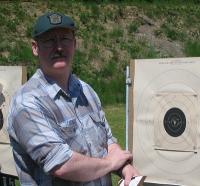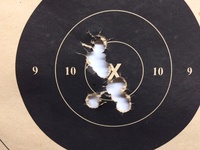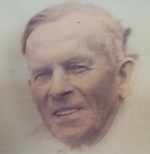Pure lead bullets?
+5
jglenn21
Wobbley
JKR
fc60
bruce martindale
9 posters
Page 1 of 1
 Pure lead bullets?
Pure lead bullets?
I have always cast alloy bullets consisting of wheel weights, at BHN 9, or other hardstuff like pure and linotype etc.
Antimonial leads are hard but getting hard to find.
I cast a bunch out of pure lead with one or two percent tin added so the mould would fill nicely. I was surprised at how well they performed with light indoor loads like 3.5 BE. They take special loading methods to prevent swaging down during seating. The latter is a big cause of leading.
Noting that the Star and Zeroes are also swaged pure lead, l think these could also work well outdoors.
Has anyone else played with it?
Antimonial leads are hard but getting hard to find.
I cast a bunch out of pure lead with one or two percent tin added so the mould would fill nicely. I was surprised at how well they performed with light indoor loads like 3.5 BE. They take special loading methods to prevent swaging down during seating. The latter is a big cause of leading.
Noting that the Star and Zeroes are also swaged pure lead, l think these could also work well outdoors.
Has anyone else played with it?
 Re: Pure lead bullets?
Re: Pure lead bullets?
Greetings Bruce,
Noting that the Star and Zeroes are also swaged pure lead,
Are the bullets truly Pure Lead? Have you hardness tested them?
I have yet to encounter a commercially swaged bullet that is Pure Lead.
When swaging my own 32 HBWC bullets, I tested Pure Lead, 1:20 Tin:Lead, and salvage 22lr metal.
All shot well.
The 1:20 alloy is excellent for casting. Pure Lead second, and 22lr salvage last.
As expected, Pure Lead swages with the lease effort (5 HBN)
1:20 and 22lr salvage offered much more resistance (8 HBN)
For my revolver bullets with low pressure, I like 1:20 alloy. The major downside is cost. Tin is pricey and Pure Lead is getting more difficult to source. It may be possible to go with 1:30 or 1:40 Tin:Lead alloy.
Cheers,
Dave

fc60- Posts : 1458
Join date : 2011-06-11
Location : South Prairie, WA 98385
 Re: Pure lead bullets?
Re: Pure lead bullets?
Bruce,
It's my opinion that softer is better as long as the fit is good. I'm talking about 45 bullets for bullseye shooting. I've been casting with range scrap which is heavily 22 bullets. I mix a bit of linotype with it to help it fill nicely. Using the Lyman mould that I recently got from you, I noted that my first batch of bullets dropped at .451''-.4515''. I checked about twenty and they were very consistent so I tumbled lubed them with my mix of 45-45-10 and loaded them unsized with 3.7 BE which is my usual long line load. They shot fantastic at 50 yards! In fact I shot a 99-6 fifty yard slow fire which is a bit over my head.
For the next batch I added quite a bit more lino to the mix in order to bring the size up a bit. The bullets dropped at .453. I sized and lubed them to .452 with a conventional lube sizer. In testing I discovered this batch wouldn't shoot near as well as the softer, unsized bullets.
I've talked casting with very good shooters who cast very hard bullets, but so far I've had the best results with softer.
Jim
It's my opinion that softer is better as long as the fit is good. I'm talking about 45 bullets for bullseye shooting. I've been casting with range scrap which is heavily 22 bullets. I mix a bit of linotype with it to help it fill nicely. Using the Lyman mould that I recently got from you, I noted that my first batch of bullets dropped at .451''-.4515''. I checked about twenty and they were very consistent so I tumbled lubed them with my mix of 45-45-10 and loaded them unsized with 3.7 BE which is my usual long line load. They shot fantastic at 50 yards! In fact I shot a 99-6 fifty yard slow fire which is a bit over my head.
For the next batch I added quite a bit more lino to the mix in order to bring the size up a bit. The bullets dropped at .453. I sized and lubed them to .452 with a conventional lube sizer. In testing I discovered this batch wouldn't shoot near as well as the softer, unsized bullets.
I've talked casting with very good shooters who cast very hard bullets, but so far I've had the best results with softer.
Jim
JKR- Posts : 763
Join date : 2015-01-13
Location : Northern Wisconsin
 Re: Pure lead bullets?
Re: Pure lead bullets?
Regardless of method of manufacture, softer bullets have a velocity limitation. For commercial swaged (whatever the alloy), this seems to be 850-900fps. Fortunately this is above typical Bullseye velocities. But it has to be respected.

Wobbley- Admin
- Posts : 4802
Join date : 2015-02-13
 Re: Pure lead bullets?
Re: Pure lead bullets?
Thanks all, these are actually spent pellets and lo and behold they test out at 9 bhn, just like wheel weights. So as George Carlin said " save your carfare, you're already there"
 Re: Pure lead bullets?
Re: Pure lead bullets?
We had a thread on the commercially swaged lead from Zero and Magnus as to what they used. Believe it was the std. 6-2-92 used in their cast bullets. Softer than cast as casting tends to harden the bullets.

jglenn21- Posts : 2620
Join date : 2015-04-07
Age : 76
Location : monroe , ga
 Re: Pure lead bullets?
Re: Pure lead bullets?
I've never owned a hardness tester other than my thumbnail. Maybe it's time. What do you guys recommend?
Jim
Jim
JKR- Posts : 763
Join date : 2015-01-13
Location : Northern Wisconsin
 Re: Pure lead bullets?
Re: Pure lead bullets?
Saeco or LBT

jglenn21- Posts : 2620
Join date : 2015-04-07
Age : 76
Location : monroe , ga
 Re: Pure lead bullets?
Re: Pure lead bullets?
I have both... and others... both can be finicky, but I'd get the lbt over the saeco, especially as your eyes start to age... the lbt is much easier to read, but a little trickier to use. Consistancy is the key as with a lot of things bullseye related...jglenn21 wrote:Saeco or LBT
10sandxs- Posts : 972
Join date : 2016-01-29
 Re: Pure lead bullets?
Re: Pure lead bullets?
I shoot schuetzen rifles for which I cast bullets that are 30-1 (30 parts lead to 1 part tin). The addition of tin does add a little hardness but I use it primarily to get perfectly filled out bullets. Anyway, I shoot these bullets at 1250-1400 fps with little or no leading. So, I think its a non issue at the velocities we shoot bullseye loads.
Phil
Phil

PMcfall- Posts : 395
Join date : 2011-06-16
Location : St. Joseph, MO
 Re: Pure lead bullets?
Re: Pure lead bullets?
I agree with 10sandsxs ,I also have both and the LBT is a better device . It's easy to use ,repeats, and you can also test ingots with it.10sandxs wrote:I have both... and others... both can be finicky, but I'd get the lbt over the saeco, especially as your eyes start to age... the lbt is much easier to read, but a little trickier to use. Consistancy is the key as with a lot of things bullseye related...jglenn21 wrote:Saeco or LBT
Bubba Blaster- Posts : 187
Join date : 2013-10-20
 Re: Pure lead bullets?
Re: Pure lead bullets?
I have an LBT hardnes tester easy to use. Zeroes test out at 7 so they aren't pure either.
From Bert Brookes, remember him? He said there were two 22 bullets 1% antimony and 0.1 for the black bullet line. So most 22 range scrapwill be low antimonial leads.
Jim, a 99 unsized? Good on ya!
From Bert Brookes, remember him? He said there were two 22 bullets 1% antimony and 0.1 for the black bullet line. So most 22 range scrapwill be low antimonial leads.
Jim, a 99 unsized? Good on ya!
 Re: Pure lead bullets?
Re: Pure lead bullets?
Bruce,
Couldn't believe it myself! I am really liking that mould!
Jim
Couldn't believe it myself! I am really liking that mould!
Jim
JKR- Posts : 763
Join date : 2015-01-13
Location : Northern Wisconsin
 Re: Pure lead bullets?
Re: Pure lead bullets?
Molds are regulated with different alloys by the manufactures. This can effect bullet diameter as it drops from the mould.
Using antimony will make a larger diameter and harder bullet. Tin will also, but needing more to reach the same hardness.
I just add linotype to get the correct diameters .
22 lr bullets are pure lead with a antimony outer coating. This coating, with lube keeps them from leading.
Some match grade 22 lr have up to 2% antimony added.
Bullet leads analyzed from CCI, Federal, Remington, and Winchester have contained up to 0.42 percent arsenic, 6.8 percent antimony, 2.5 percent tin, 0.2 percent bismuth, 0.22 percent copper, 0.031 percent silver, and 0.011 percent cadmium. The wide ranges in concentrations of all of these elements within sources provide for thousands of distinguishable melts of bullet lead at any one time.
Using antimony will make a larger diameter and harder bullet. Tin will also, but needing more to reach the same hardness.
I just add linotype to get the correct diameters .
22 lr bullets are pure lead with a antimony outer coating. This coating, with lube keeps them from leading.
Some match grade 22 lr have up to 2% antimony added.
Bullet leads analyzed from CCI, Federal, Remington, and Winchester have contained up to 0.42 percent arsenic, 6.8 percent antimony, 2.5 percent tin, 0.2 percent bismuth, 0.22 percent copper, 0.031 percent silver, and 0.011 percent cadmium. The wide ranges in concentrations of all of these elements within sources provide for thousands of distinguishable melts of bullet lead at any one time.

243winxb- Posts : 344
Join date : 2013-12-01
Age : 80
Location : USA
 Similar topics
Similar topics» Using Lead and Jacketed Bullets
» Seating die for lead bullets
» H&N lead bullets 85grs WC.
» crimping 38 cal lead bullets
» Info please, Zero lead bullets, 38/357
» Seating die for lead bullets
» H&N lead bullets 85grs WC.
» crimping 38 cal lead bullets
» Info please, Zero lead bullets, 38/357
Page 1 of 1
Permissions in this forum:
You cannot reply to topics in this forum